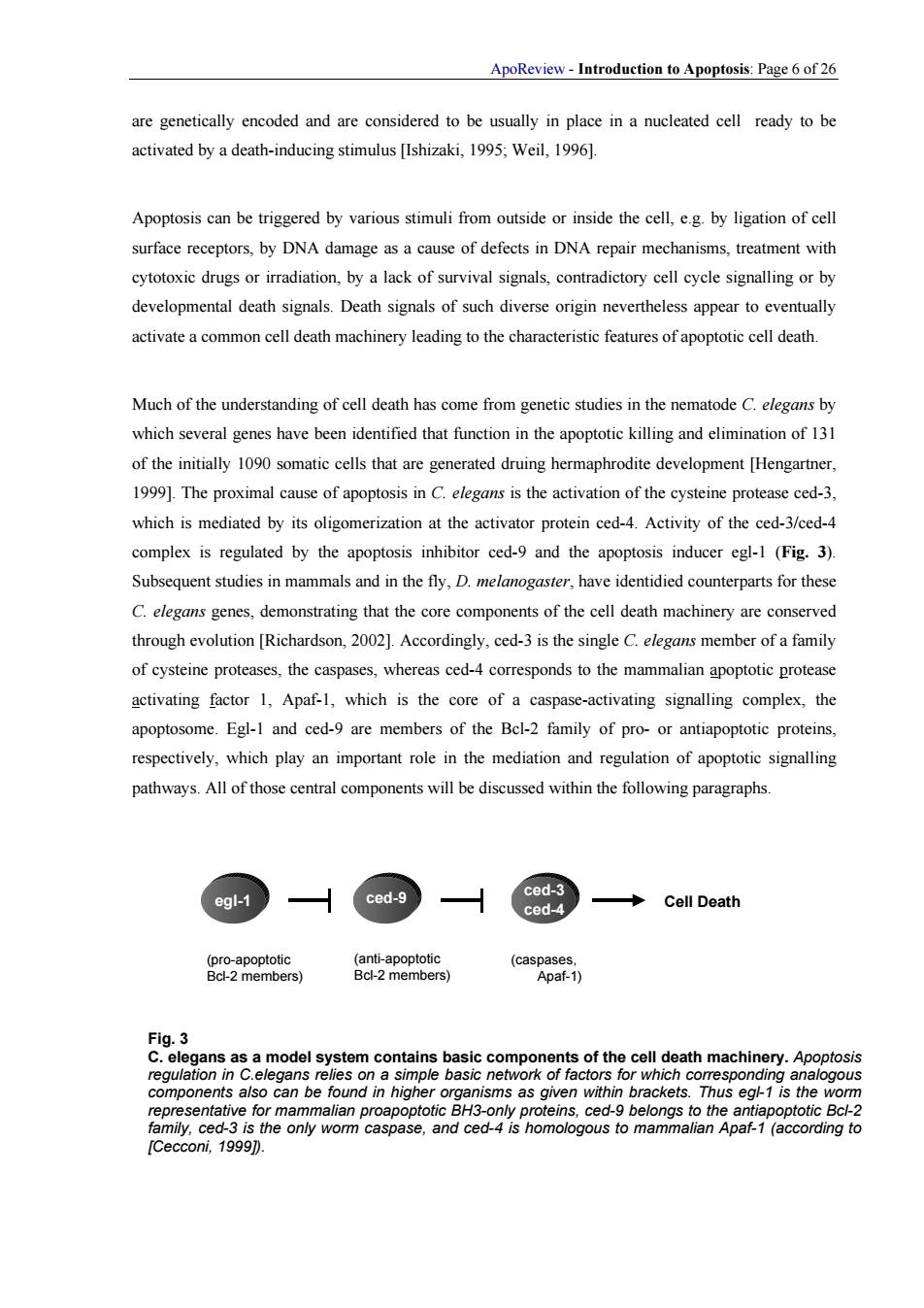正在加载图片...

ApoReview-Introduction to Apoptosis:Page 6 of26 are genetically encoded and are considered to be usually in place in a nucleated cell ready to be activated by a death-inducing stimulus [shizaki,199]. Apoptosis can be triggered by various stimuli from outside or inside the celle.g.by ligation of cell surface receptors,by DNA damage as a cause of defects in DNA repair mechanisms,treatment with cytotoxic drugs or irradiation,by a lack of survival signals,contradictory cell cycle signalling or by developmental death signals.Death signals of such diverse origin nevertheless appear to eventually activate a common cell death machinery leading to the characteristic features of apoptotic cell death. Much of the understanding of cell death has come from genetic studies in the nematode C.elegans by which several genes have been identified that function in the apoptotic killing and elimination of 131 of the initially 109 somatic cells that are generated druing hermaphrodite development [Hengartner. 1999].The proximal cause of apoptosis in C.elegans is the activation of the cysteine protease ced-3. which is mediated by its oligomerization at the activator protein ced-4.Activity of the ced-3/ced-4 complex is regulated by the apoptosis inhibitor ced-9 and the apoptosis inducer egl-1 (Fig.3). Subsequent studies in mammals and in the fly,D.melanogaster,have identidied counterparts for these C.elegans genes,demonstrating that the core components of the cell death machinery are conserved through evolution [Richardson,2002]Accordingly,ced-3 is the single C.elegans member of a family of cysteine proteases,the caspases,whereas ced-4 corresponds to the mammalian apoptotic protease activating factor 1,Apaf-1,which is the core of a caspase-activating signalling complex,the apoptosome.Egl-1 and ced-9 are members of the Bcl-2 family of pro-or antiapoptotic proteins. respectively,which play an important role in the mediation and regulation of apoptotic signalling pathways.All of those central components will be discussed within the following paragraphs. ced-s ced-3 ced-4 →Cell Death (anti-a ototic Bcl-2 members) (ca Fig.3 ans as a model s ystem contains basic components of the cell death machinery.Apoptosis tsalsogan alogous ma malian pro 8H3 teins.ced ne only worm caspase,and ced o ma (according to ApoReview - Introduction to Apoptosis: Page 6 of 26 are genetically encoded and are considered to be usually in place in a nucleated cell ready to be activated by a death-inducing stimulus [Ishizaki, 1995; Weil, 1996]. Apoptosis can be triggered by various stimuli from outside or inside the cell, e.g. by ligation of cell surface receptors, by DNA damage as a cause of defects in DNA repair mechanisms, treatment with cytotoxic drugs or irradiation, by a lack of survival signals, contradictory cell cycle signalling or by developmental death signals. Death signals of such diverse origin nevertheless appear to eventually activate a common cell death machinery leading to the characteristic features of apoptotic cell death. Much of the understanding of cell death has come from genetic studies in the nematode C. elegans by which several genes have been identified that function in the apoptotic killing and elimination of 131 of the initially 1090 somatic cells that are generated druing hermaphrodite development [Hengartner, 1999]. The proximal cause of apoptosis in C. elegans is the activation of the cysteine protease ced-3, which is mediated by its oligomerization at the activator protein ced-4. Activity of the ced-3/ced-4 complex is regulated by the apoptosis inhibitor ced-9 and the apoptosis inducer egl-1 (Fig. 3). Subsequent studies in mammals and in the fly, D. melanogaster, have identidied counterparts for these C. elegans genes, demonstrating that the core components of the cell death machinery are conserved through evolution [Richardson, 2002]. Accordingly, ced-3 is the single C. elegans member of a family of cysteine proteases, the caspases, whereas ced-4 corresponds to the mammalian apoptotic protease activating factor 1, Apaf-1, which is the core of a caspase-activating signalling complex, the apoptosome. Egl-1 and ced-9 are members of the Bcl-2 family of pro- or antiapoptotic proteins, respectively, which play an important role in the mediation and regulation of apoptotic signalling pathways. All of those central components will be discussed within the following paragraphs. egl-1 ced-9 ced-3 ced-4 Cell Death (pro-apoptotic Bcl-2 members) (anti-apoptotic Bcl-2 members) (caspases, Apaf-1) Fig. 3 C. elegans as a model system contains basic components of the cell death machinery. Apoptosis regulation in C.elegans relies on a simple basic network of factors for which corresponding analogous components also can be found in higher organisms as given within brackets. Thus egl-1 is the worm representative for mammalian proapoptotic BH3-only proteins, ced-9 belongs to the antiapoptotic Bcl-2 family, ced-3 is the only worm caspase, and ced-4 is homologous to mammalian Apaf-1 (according to [Cecconi, 1999])